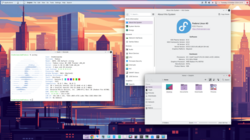Why I use KDE
Over the decades, my primary operating system of choice has changed a few times. As a wee child of six years old, we got out first PC through one of those employer buy-a-PC programs, where an employer would subsidize its employees buying PCs for use in the home. The goal here was simple: if people get comfortable with a computer in their private life, they’ll also get comfortable with it in their professional life. And so, through my mother’s employer, we got a brand new 286 desktop running MS-DOS and Windows 3.0. I still have the massive and detailed manuals and original installation floppies it came with.
So, my first operating system of ‘choice’ was MS-DOS, and to a far lesser extent Windows 3.0. As my childhood progressed, we got progressively better computers, and the new Windows versions that came with it – Windows 95, 98, and yes, even ME, which I remarkably liked just fine. Starting with Windows 95, DOS became an afterthought, and with my schools, too, being entirely Windows-only, my teenage years were all Windows, all the time. So, when I bought my first own, brand new computer – instead of old 386 machines my parents took home from work – right around when Windows XP came out, I bought a totally legal copy of Windows XP from some dude at school that somehow came on a CD-R with a handwritten label but was really totally legit you guys.
I didn’t like Windows XP at all, and immediately started looking for alternatives, trying out Mandrake Linux before discovering something called BeOS – and despite BeOS already being over by that point, I had found my operating system of choice. I tried to make it last as long as the BeOS community would let me, but that wasn’t very long. The next step was a move to the Mac, something that was quite rare in The Netherlands at that time. During that same time, Microsoft released Windows Server 2003, the actually good version of Windows XP, and a vibrant community of people, including myself, started using it as a desktop operating system instead.

